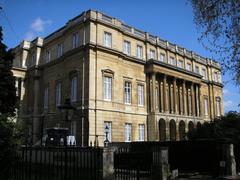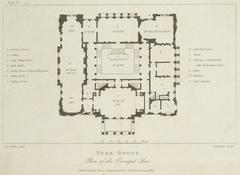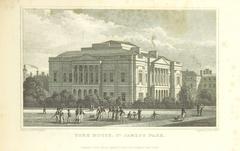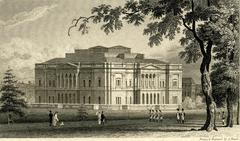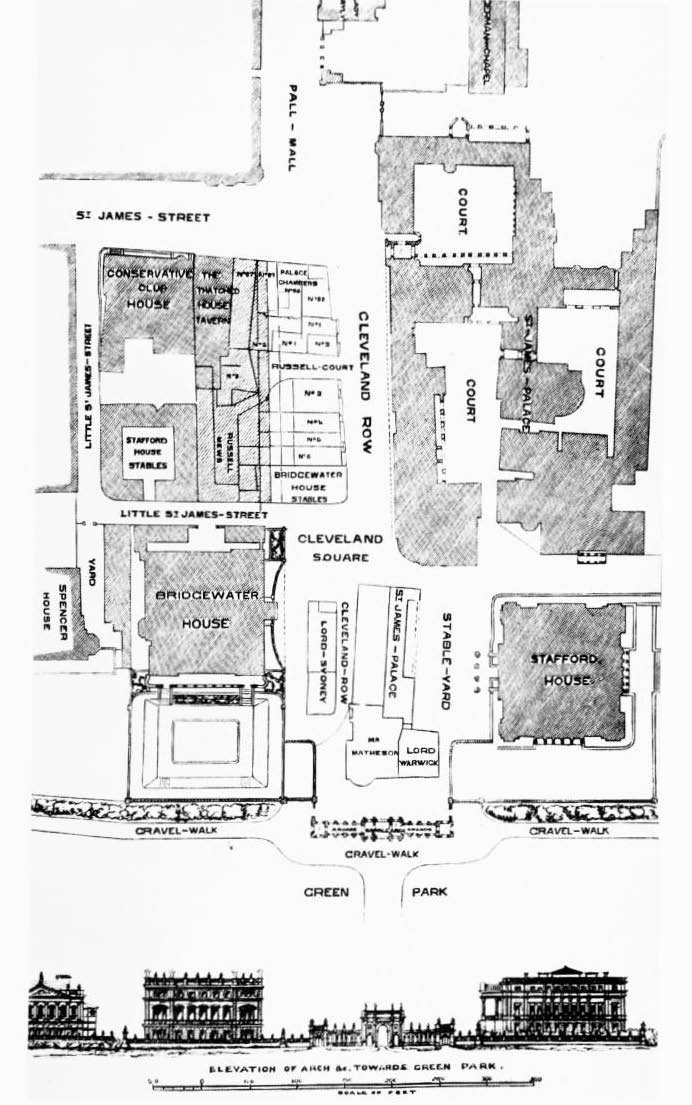
Lancaster House London: Visiting Hours, Tickets, and History Guide
Date: 14/06/2025
Introduction
Lancaster House stands as a quintessential emblem of London’s architectural splendor and rich historical tapestry. Nestled conveniently near Buckingham Palace, it is a superb example of neoclassical design, blending late Georgian classicism with opulent French Louis XIV influences. Commissioned in the early 19th century for Prince Frederick, Duke of York and Albany, and shaped by architects such as Sir Robert Smirke, Benjamin Dean Wyatt, Philip Wyatt, and Sir Charles Barry, its imposing Bath stone façade, giant Corinthian porticoes, and lavish interiors have made it a captivating destination for those intrigued by British aristocratic heritage and international diplomacy (Historic England; FCDO Blog; GOV.UK).
Beyond its architectural grandeur, Lancaster House has been the stage for pivotal diplomatic events, from Victorian high society gatherings to the post-World War II peace negotiations, and the historic Lancaster House Agreement that paved the way for Zimbabwe’s independence (FCDO Blog; Springer Link). While it primarily serves as a government venue, Lancaster House occasionally opens its doors to the public during special events like Open House London, offering rare glimpses into its magnificent state rooms and gardens. This guide provides all essential information on Lancaster House visiting hours, tickets, architectural highlights, history, travel tips, and nearby attractions to help you make the most of your visit.
Table of Contents
- Introduction
- Early Origins and Construction
- Architectural Evolution and Interior Design
- Social and Political Significance
- Transition to Public Ownership and Modern Use
- Visitor Information: Hours, Tickets, and Accessibility
- Travel Tips and Nearby Attractions
- Notable Events and Cultural Impact
- Frequently Asked Questions (FAQ)
- Visual and Virtual Resources
- Conclusion and Call to Action
- References
Early Origins and Construction
Lancaster House was conceived in the early 19th century for Prince Frederick, Duke of York and Albany. Construction began around 1820. Initially, Sir Robert Smirke provided the neoclassical designs, which were later re-envisioned by Benjamin Dean Wyatt and Philip Wyatt (Historic England). The mansion was ultimately completed between 1833 and 1838 for the 2nd Duke of Sutherland (then called Stafford House), with Sir Charles Barry finalizing the decorative interiors. Its structure features Bath stone, a slate roof, giant Corinthian porticoes, and a classical style characterized by grand two-storey facades, a basement, and attic. Key highlights include the nine-window north and south facades and a dramatic five-bay portico centerpiece (Historic England; Off to London).
Architectural Evolution and Interior Design
Lancaster House’s interiors reflect the opulence of the Louis XIV style, with Baroque and Rococo influences. Benjamin Wyatt’s work created lavish white and gold ornamentation set against rich hues. The Long Gallery, stretching over 35 meters with 18 windows, provides dramatic natural light. The Gold Room features original chandeliers and an antique Parisian clock, while the Music Room offers Corinthian columns and elegant recesses. The state rooms are adorned with ceiling paintings and period furniture, with artwork including pieces by Guercino and copies of Veronese (FCDO Blog; Historic England).
Social and Political Significance
From its earliest days, Lancaster House became a center for political and cultural life. Following the Duke of York’s death, the Sutherland family occupied the house, hosting luminaries such as Lord Shaftesbury, Harriet Beecher Stowe, and Giuseppe Garibaldi (British Empire). Its interiors set trends for London’s elite, and its art collections were among the most celebrated in the city (Off to London).
Transition to Public Ownership and Modern Use
In 1913, Lord Leverhulme acquired the lease and gifted the house to the nation, renaming it Lancaster House. It served as the London Museum for a time before becoming a prime government hospitality venue. Today, under the management of the Foreign, Commonwealth & Development Office, the house hosts international conferences, state occasions, and diplomatic events. Its gardens border St James’s Park and provide unique views of Buckingham Palace, The Mall, and Green Park (FCDO Blog).
As a Grade I listed building, Lancaster House is recognized for its exceptional architectural and historic value (Historic England).
Visitor Information: Visiting Hours, Tickets, and Accessibility
Lancaster House is not regularly open to the public. Access is typically granted during special events such as Open House London or Heritage Open Days. When available, tickets are often free but require advance booking due to high demand (English Heritage; Free Tours by Foot). Visitors should monitor official channels for announcements.
Accessibility accommodations are made during open days, with ramps and accessible restrooms provided where possible. However, due to the historic nature of the building, some areas may be less accessible. Always check in advance and arrange necessary assistance.
Travel Tips and Nearby Attractions
Lancaster House is centrally located, just steps from Buckingham Palace, St James’s Park, Green Park, and The Mall. The nearest Underground stations are Green Park and Hyde Park Corner. Consider combining your visit with other landmarks such as The Royal Mews or The National Gallery. Arrive early during open events, as security checks may take time, and bring a photo ID.
Notable Events and Cultural Impact
Lancaster House has hosted key historical moments, including post-World War II peace negotiations, the founding of NATO, decolonization conferences, and the landmark Lancaster House Agreement for Zimbabwe’s independence (FCDO Blog; Springer Link). It has also been a filming location for productions such as “The King’s Speech” and “The Crown.”
Frequently Asked Questions (FAQ)
Q: Is Lancaster House open to the public daily?
A: No, it is generally closed except for special events or open days. Check official sources for dates and booking information.
Q: How do I get tickets for visiting Lancaster House?
A: Tickets are released in advance for open days and are available through official government or heritage websites.
Q: Is the house accessible for people with disabilities?
A: Efforts are made to provide accessibility during special events, but some areas may be limited. Contact the venue in advance with specific needs.
Q: Where is Lancaster House located?
A: Stable Yard, St. James’s, London SW1A 1BB, near Buckingham Palace and accessible from Green Park and Hyde Park Corner stations.
Q: Can I take photographs inside?
A: Photography is generally restricted inside the house, but the exterior and gardens offer excellent photo opportunities.
Visual and Virtual Resources
- High-quality images and virtual tours are available via the Government Art Collection website.
- Suggested visuals include:
- Exterior shots of the neoclassical façade (alt text: “Lancaster House neoclassical exterior with Corinthian porticoes”)
- Interior photographs of the Long Gallery and Gold Room (alt text: “Lancaster House Long Gallery interior with skylight”)
- Historical event images (alt text: “Historic banquet at Lancaster House”)
Conclusion and Call to Action
Lancaster House endures as a jewel of London’s historic and diplomatic landscape, blending neoclassical grandeur with a legacy of international diplomacy. While public access is rare, special open days provide an extraordinary opportunity to explore its magnificent interiors and storied past. Plan ahead, secure your tickets early, and enhance your London itinerary by visiting the surrounding royal parks and historic sites.
For the latest updates on visiting hours, ticket releases, and events, consult official sources regularly. Download the Audiala app for guided tours and insider tips, and follow us on social media for the most up-to-date information and travel inspiration.
References
- Historic England, 2023, Lancaster House Listing
- FCDO Blog, 2024, Lancaster House: A World-Class Venue for Your Special Event
- GOV.UK, 2023, The Architecture of Lancaster House
- Springer Link, 2022, The Lancaster House Agreement and International Diplomacy
- English Heritage, 2024, Heritage Open Days
- Free Tours by Foot, 2024, Self-Guided London Walks
- Government Art Collection, 2024, Virtual Tours and Images
- Off to London, Lancaster House History and Tours
- British Empire, Lancaster House Article
- French Ministry of Foreign Affairs, Cybersecurity Joint Communiqué
- RUSI, Commentary on 2025 UK-EU Summit
- PromptGuides.com, 5-Day London Guide

